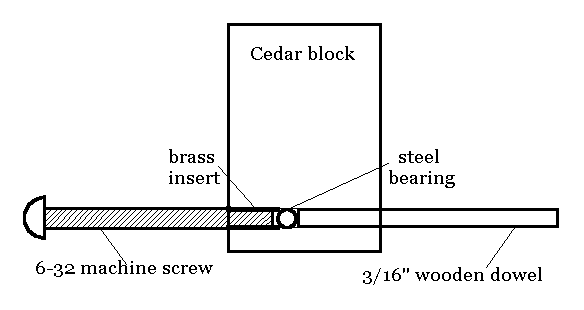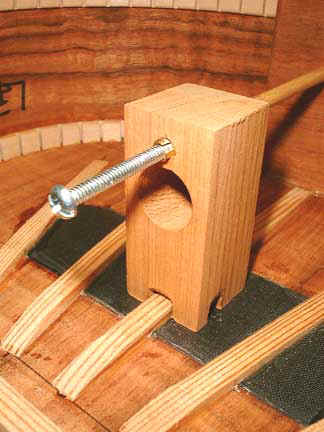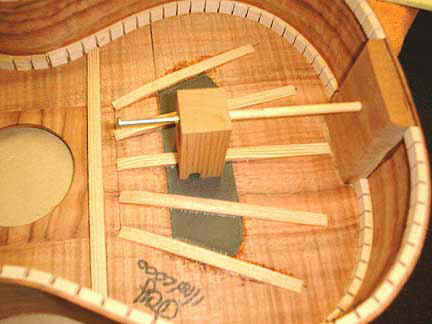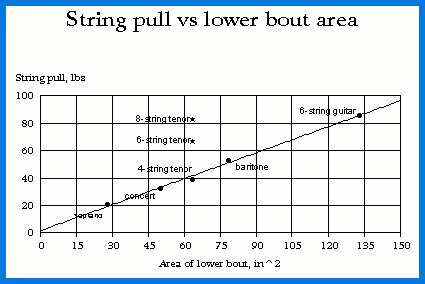Making and Installing an Ukulele “Bridge Doctor”
As mentioned earlier in the Strings page, the string pull for 6- and 8-string tenor ukuleles is considerably higher in terms of force per unit area of the top than the other ukulele sizes. This is shown in the first figure below. In order to prevent unsightly top deflection, the top must be proportionately reinforced. Additional bracing is one solution, but then the top can become less responsive and/or excessively treble sounding if the bracing is done to excess.
The good folks at J.L.D. Guitar Research created the guitar Bridge Doctor more than a decade ago. Basically, the device attaches to the underside of the guitar bridge. An adjustable rod extends from the base of the bridge doctor to the tail block. For a new instrument, the rod is adjusted so as to just touch the tail block; string tension then rotates the Bridge Doctor ever so slightly so that firm contact is made between the rod and the tail block. It is my understanding that some form of the device is currently used on most of the new instruments at Breedlove Guitars. After a great talk with Steve Henderson at Breedlove, I came up with a smaller version of the Bridge Doctor for my tenor ukuleles.
As shown above, the basic unit consists of a Western red cedar block 1″ square by 2″ deep. I chose cedar because of its light weight. I’m sure that redwood would also do well, but haven’t tried it. About 3/8″ from the bottom, a 6-32 x 1/4″ brass insert is centered on one face of the block. The hole for the insert is enlarged from the other side to fit a 3/16″ wooden dowel. A small bearing fits between the end of the dowel and the end of the 6-32 machine screw as it emerges from the inside end of the brass insert. I use a BB for this purpose. The fit of the dowel should be close but easily moved by the screw. When cutting the length of the dowel, make sure that the machine screw is not protruding from the inside of the insert and that the sphere is in place. The end of the dowel which touches the sphere should be flat while the end touching the tail block should be nicely rounded. I usually leave ~ 1/16″ space between the tail block and dowel end when doing the gluing up operation.
 The photo herein shows one of the little beauties in place, awaiting final adjustments and gluing. Let’s review the various parts that we can see. The block itself is sitting on one of my graphite carbon epoxy composite bridge plates and is centered on the middle strut of the fan bracing. The front edge of the Bridge Doctor coincides with the front edge of the bridge when the latter is eventually glued in place. A 5/8″ hole can be drilled through the block if a pickup such as a Fishman Natural I or II will be installed. Emerging from the left is the 6-32 machine screw (1 1/2 to 1 3/4″ in length). The outer portion of the brass insert is just visible. Exiting the rear of the Bridge Doctor is the 3/16″ wooden dowel which just touches the tail block at installation. A notch is cut in the gluing surface to accommodate the fan brace. A second cross notch can also be seen; I no longer cut this notch. I epoxy the Bridge Doctor in, being careful to saturate the end grain before final placement, as discussed in the neck-to-body webpage on this site. It should be stressed once more that the dowel should just touch the tail block with no string tension. After the instrument is strung up, there will be sufficient pressure pushing the dowel against the tail block so that no buzzing will occur.
The photo herein shows one of the little beauties in place, awaiting final adjustments and gluing. Let’s review the various parts that we can see. The block itself is sitting on one of my graphite carbon epoxy composite bridge plates and is centered on the middle strut of the fan bracing. The front edge of the Bridge Doctor coincides with the front edge of the bridge when the latter is eventually glued in place. A 5/8″ hole can be drilled through the block if a pickup such as a Fishman Natural I or II will be installed. Emerging from the left is the 6-32 machine screw (1 1/2 to 1 3/4″ in length). The outer portion of the brass insert is just visible. Exiting the rear of the Bridge Doctor is the 3/16″ wooden dowel which just touches the tail block at installation. A notch is cut in the gluing surface to accommodate the fan brace. A second cross notch can also be seen; I no longer cut this notch. I epoxy the Bridge Doctor in, being careful to saturate the end grain before final placement, as discussed in the neck-to-body webpage on this site. It should be stressed once more that the dowel should just touch the tail block with no string tension. After the instrument is strung up, there will be sufficient pressure pushing the dowel against the tail block so that no buzzing will occur.
 The figure to the right shows a larger scale view of the Bridge Doctor installation in one of my 6- or 8-string tenors. Putting the Bridge Doctor in also allows me to make the bracing somewhat lighter, again increasing the possibility of a more responsive instrument. I have installed about 15-20 of these devices so far and customers have been uniformly happy with the results. The instruments have good volume and sustain and the tops have remained faithfully un-warped. I am not selling this version of the Bridge Doctor, since it is so simple to make and install. If anyone were to wish to do so, they should contact J.L.D. Guitar Research before going further.
The figure to the right shows a larger scale view of the Bridge Doctor installation in one of my 6- or 8-string tenors. Putting the Bridge Doctor in also allows me to make the bracing somewhat lighter, again increasing the possibility of a more responsive instrument. I have installed about 15-20 of these devices so far and customers have been uniformly happy with the results. The instruments have good volume and sustain and the tops have remained faithfully un-warped. I am not selling this version of the Bridge Doctor, since it is so simple to make and install. If anyone were to wish to do so, they should contact J.L.D. Guitar Research before going further.
I enjoy writing these pages and hope that they are interesting and useful to the reader. I’ve stopped building at this time and still need to generate some income in order to continue to expand this website with more useful articles. If this page was helpful to you and you would like to make a $5.00 donation in order to have more pages like it, please use the donation button below. Thank you.
